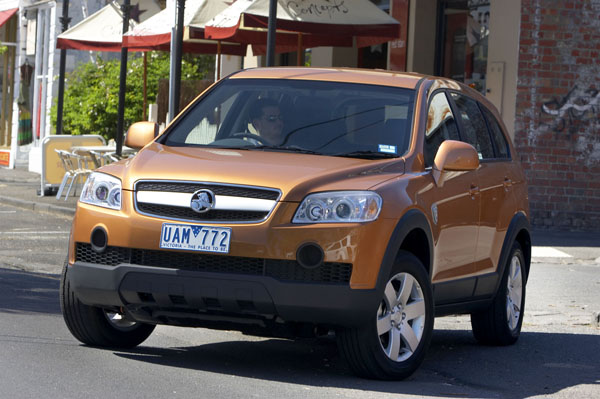
2006 Holden Captiva
Holden Captiva is a medium sized SUV, buyers tell us they chose it because of its
good interior space after comparison with competitors such as Ford Territory and
Toyota Kluger.
Sales were high from the time it went on sale in 2006 so there are plenty of Captivas
to choose from in the used-car scene. Take advantage of this to find one in that suits
your needs and budget.
Though the Captiva is imported from the General Motors Daewoo factory in South
Korea it has extensive Australian input in its body styling and mechanicals.
Holden Captiva is offered with five and seven seats. The third-row seats can carry
adults in moderate comfort, but are better suited to pre-teen children.
Boot space when all seven seats are in place is minimal, which is hardly a surprise
as this is a relatively small vehicle. If you want more passenger/luggage space it
might be better to choose a larger SUV.
2011 Holden Captiva
The rear seats can the folded down in several ways, when all are flat, you have a
handy 1565 litres of cargo space.
There are many small stowage compartments throughout the cabin. The large
wet/dry area beneath the load compartment floor. Is an excellent idea.
There’s a sort-of sporting model called the Holden Captiva Maxx.
Initially all Captivas had a part-time 4WD system, with drive normally being to the
front wheels and the rear wheels being engaged when extra traction was demanded.
While the Captiva is not a heavy-duty 4WD it can go surprisingly far in the hands of
an experienced driver.
A 2WD version, driven through the front wheels, was introduced in December 2009.
Called the Captiva 5 and using the Maxx style body it’s a powered by a 2.4-litre four-
cylinder petrol engine.
When introduced the only Captiva engine was a 3.2-litre V6 petrol built in Australia
by Holden and a close cousin of the Commodore engine. A 2.0-litre diesel engine
was added to the options list a few months later.
2016 Holden Captiva
A five-speed automatic with manual overrides was the only transmission until the
arrival of the Captiva 5, which is offered with a six-speed manual as well as the
automatic transmission.
The automatics were upgraded to six forward ratios with the introduction of a
facelifted Captiva in February 2011.
All models come with electronic stability control, ABS brakes with brake assist,
traction control, active rollover protection and descent control. There are dual front
airbags in all models with side curtain airbags optional in the lower cost models and
standard on the others.
Captiva got what proved to be its final major makeover at the start of 2016, with an
updated face, interior changes and added technology.
Despite the brand now gone, Holden still operate almost everywhere in Australia.
Most will stock the more common spare parts for the Captiva. Other parts can
usually be shipped in within a couple of working days. Parts prices are often lower
than average for an imported vehicle in this class.
Service and repair costs are reasonable and the relatively simple layout of the
Captiva means the good amateur mechanic can do a fair bit of their own work.
Safety related areas should only be carried out by professionals.
Insurance costs are reasonable and we haven’t seen a big variation between
companies. However, it’s always smart to shop around for the best deal making sure
that you’re comparing apples with apples when doing so.
Holden took the Captiva from the Australian market during 2018 just before the
company extended its warranty from three to five years although some models may
be covered under a special seven-year cover if it was purchased in 2017.
All vehicles sold in Australia must guarantee availability of spare parts and servicing
for a minimum of 10 years. In the absence of Holden dealerships this is available
through a General Motors national aftersales network.
WHAT TO LOOK FOR
Engines that are slow to start or blow smoke when worked hard may be due for
major repairs.
Look for oil leaks under the engine and the transmission. Check the engine dipstick
to be sure the oil level is significantly above the ‘low’ mark.
Automatic transmissions that don’t go into Drive quickly when moved from Neutral or
Reverse may need servicing – possibly even major repairs.
Make sure that all warning lights are out after the engine’s been running for a few
seconds.
Check for rust in the lower area of the body and in a Captiva that may have been
used on the beach.
Look over the interior for signs of dirt having been ground into the carpets. Similarly,
check for damage and/or stains on the seats.
Look for off-road damage to the bumper corners, the door sills and for light scratches
in the paintwork on the doors and the front guards.
If the load area has been used to carry heavy items there could be damage to the
panels and floor.
HOW MUCH?
Expect to pay from $3000 to $6000 for any pre-2011 Holden Captiva; $6000 to
$10,000 for a 2011 Captiva 5; $7000 to $11,000 for a Captiva 7 LX; $8000 to
$12,000 for 2013 Captiva 7 CX; $9000 to $13,000 for a 2014 Captiva 5 LTZ; $11,000
to $16,000 for a 2015 Captiva 7 LTZ AWD; $13,000 to $19,000 for a Captiva 7 LT
AWD; and $15,000 to $22,000 for a Captiva 7 LTZ AWD.
CAR BUYING TIP
Thinking of buying an SUV? Many are used only on sealed roads, others are driven
off-road and may have been knocked about. Guess which is the best buy…
RECALLS: To browse recalls on all vehicles go to the ACCC at:
www.productsafety.gov.au/products/transport/cars/